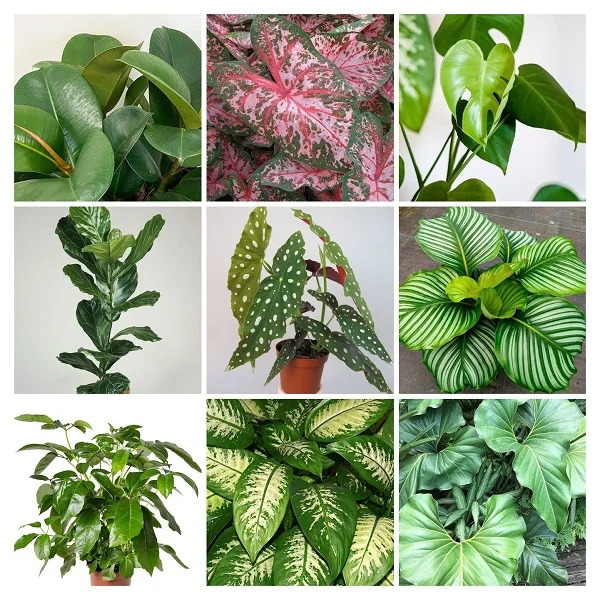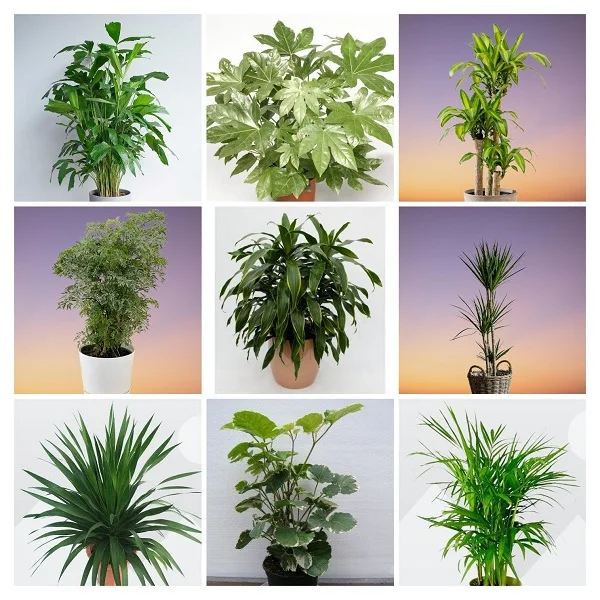25 Best Large Low Light Indoor Plants for the Living Room
Some links in this post may be affiliate links
Large low light indoor plants make a bold statement, create a wow factor in any space which will give the living room a spectacular and welcoming sight.
While selecting the best plants for your living room, consider the growth conditions present inorder to match them with the requirements of the plant to achieve the optimal results.
We have outlined for you herebelow 25 of the best large low light plants that you can grow to liven up your living room.
25 Large Low Light Indoor Plants for the Living Room
The best large low light plants for the living room include Swiss Cheese Plant, Anthurium metallicum, Madagascar Dragon Tree, Variegated Triangle Leaf Fig, Areca Palm, Hawaiian Schefflera, Polka Dot Begonia, Fiddle Leaf Fig, Fishtail Palm among others.
1. Swiss Cheese Plant

Botanical name: Monstera deliciosa
Common names: Swiss Cheese Plant, Split Leaf Philodendron, Monster Fruit, Mexican Breadfruit, Windowleaf Plant
Origin: Southern Mexico
Height: 20 ft
Swiss Cheese Plant is a popular plant whose large deeply perforated leaves are a sight to behold in a living room, is easy to grow and is also a good indoor air cleaner.
Monstera is ideal as a stand alone plant for occupying large empty spaces. To produce an upright plant, provide a moss stick to support it and also push the aerial roots into the soil.
Monstera deliciosa grows best in bright to medium, indirect light, warm and humid conditions and moderately moist, fertile, well-drained soil.
Learn more on how to grow and care for Swiss Cheese Plant
2. Anthurium metallicum
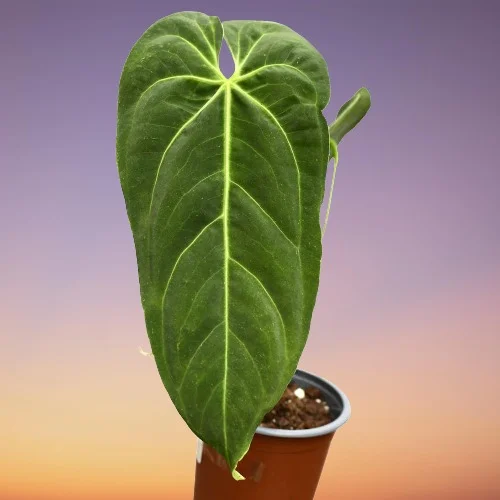
Botanical name: Anthurium metallicum
Common names: Anthurium metallicum
Origin: Columbia
Height: 6 ft
Anthurium metallicum is one of the popular Anthurium varieties on account of its large, velvety, dark-green almost black leaves with distinct veining and a beautiful metallic appearance in bright light.
The inflorescence is dark-pink to red and is about 15-20 cm long. Due to these characteristics, Anthurium metallicum is an outstanding addition to any plant collection and is sought-after by many plant enthusiasts.
Anthurium metallicum thrives in bright indirect light (filtered light), average warmth of 16-280C, humidity of 60-80% and consistently moist, fertile, well-drained, aroids potting soil coupled with monthly feeding in the growing season.
Read more on how to grow and care for Anthurium metallicum
3. Madagascar Dragon Tree
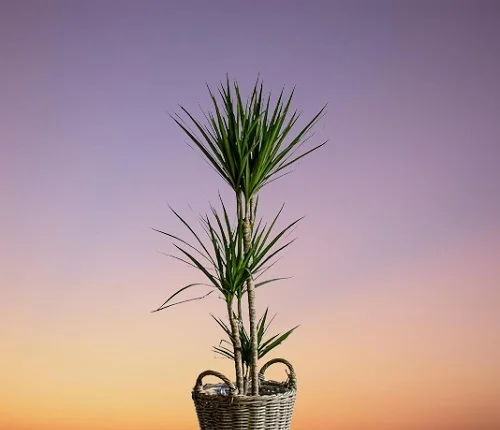
Botanical name: Dracaena marginiata
Common name: Madagascar Dragon Tree
Origin: Madagascar and other Indian Ocean Islands
Height: 8-10 ft
Madagascar Dragon Tree is a colorful plant that easily adapts to a wide range of indoor growing conditions, a good indoor air cleaner and is a magnificent splash of color in a living room.
Popular varieties of Madagascar Dragon Tree are the basic variety, Dracaena marginata, Dracaena marginata tricolor and Dracaena marginata colorama which are readily available.
Dracaena marginata requires bright, indirect light away from direct sunlight, average warmth and moderately moist, rich, well-drained soil coupled with monthly feeding during the growing season.
Learn more on how to grow and care for Madagascar Dragon Tree
4. Variegated Triangle Leaf Fig
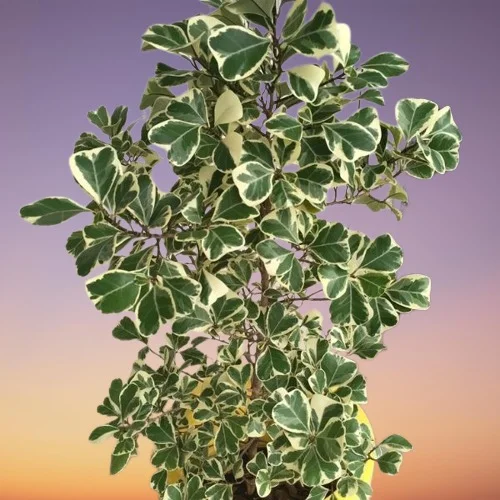
Botanical name: Ficus triangularis 'Variegata'
Common name: Variegated Triangle Leaf Fig
Origin: South and West Africa
Size: 4-6 feet tall, 4 feet wide
Variegated Triangle Leaf Fig is an evergreen, shrubby plant which bears glossy, triangular-shaped, dark-green-variegated leaves with creamy-white veins and edges.
Ficus triangularis 'Variegata' is one of the popular Ficus plants varieties on account of its spectacular foliage and ability to tolerate drought and frost conditions.
Variegated Triangle Leaf Fig prefers bright light with 4-6 hours of direct sunlight, average warmth of 16-290C, above average humidity of 60-70% and moderately moist, rich, well-drained, all purpose soil coupled with monthly feeding in the growing season.
Learn how to grow and care for Ficus triangularis 'Variegata'
5. Areca Palm
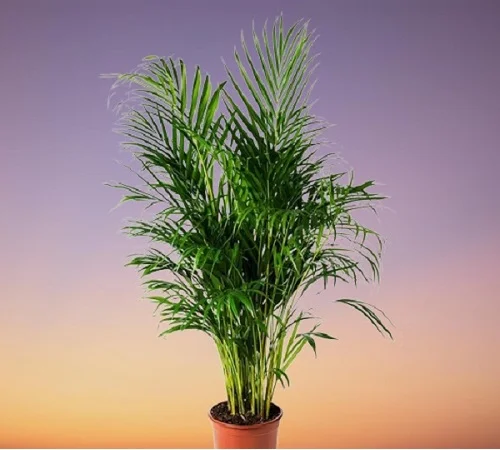
Botanical name: Dypsis lutescens
Common names: Areca Palm, Butterfly Palm, Golden Cane Palm, Yellow palm
Origin: Madagascar
Height: 6-10 ft
Areca Palm is a popular, low light, low maintenance palm which will add an unmatched exotic feel in any living room.
As indicated by the NASA Clean Air Study, Butterfly Palm is a good indoor air cleaner which gets rid of formaldehyde, xylene and toulene.
Dypsis lutescens prefers bright, indirect light away from hot direct sunlight, average warmth and humidity and moderately moist, fertile, well-drained soil accompanied by monthly feeding during the growing season.
6. Hawaiian Schefflera

Botanical name: Schefflera arboricola
Common names: Dwarf Umbrella Tree, Hawaiian Schefflera, Dwarf Schefflera
Origin: Taiwan and Hainan
Height: 4-6 ft
Hawaiian Schefflera is an easy care, fast-growing, tree-like plant with about ten leaflets radiating from each leaf-stalk which is a spectacular sight in a living room.
Many varieties of Dwarf Umbrella Tree can been selected for their variations in leaf color and pattern which are often variegated with creamy-white to yellow edges or centers.
Schefflera arboricola thrives in medium to bright light away from direct sunshine, moderate warmth and moderately moist, rich, well-drained soil coupled with monthly feeding during the growing season.
7. Polka Dot Begonia
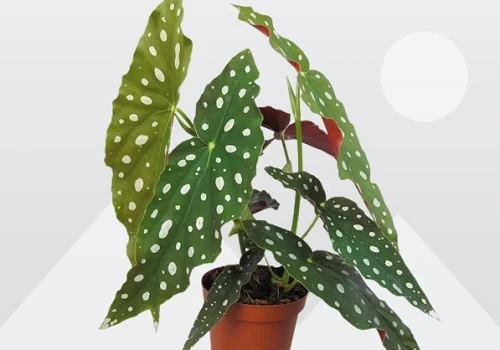
Botanical name: Begonia maculata
Common names: Polka Dot Begonia, Trout Begonia, Spotted Begonia
Origin: Brazil
Height: 8 ft
Polka Dot Begonia is an evergreen shrubby plant which bears large, glossy, olive-green leaves blotched with white dot-like spots and is a pleasant sight in the living room.
The Spotted Begonia is a cane-stemmed Begonia and bears large flower clusters which hang from the stems.
Begonia maculata grows best in bright, indirect light, average warmth, average humidity and consistently moist, fertile, well-drained soil.
Read more on how to grow and care for Polka Dot Begonia
8. Fiddle Leaf Fig
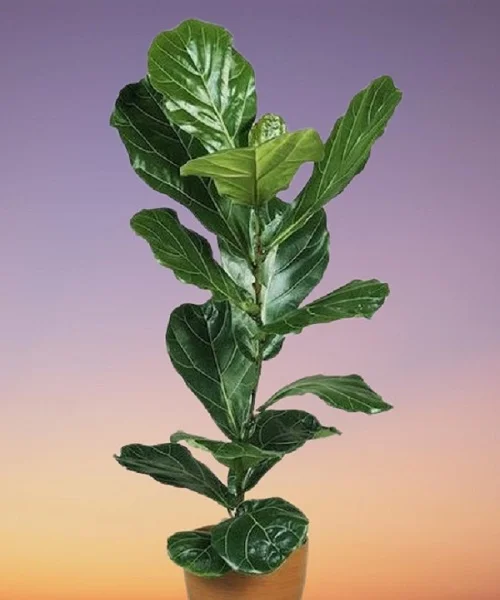
Botanical name: Ficus lyrata
Common name: Fiddle Leaf Fig
Origin: western Africa; Cameroon West to Sierra Leone
Height: 6-10 ft
Fiddle Leaf Fig is a good choice for a large low light plant. The striking large, leathery, violin-like leaves with prominent veins and a wavy margin are excellent in a living room.
Ficus lyrata is relatively tough and can withstand less than perfect conditions fairly well which makes it perfect for growing indoors.
Ficus lyrata prefers bright light with some morning direct sunlight, warm and humid conditions and moderately moist, fertile, well-drained soil coupled with monthly feeding during the growing season.
Learn more on how to grow and care for Fiddle Leaf Fig
9. Fishtail Palm

Botanical name: Caryota mitis
Common names: Fishtail Palm, Clustering Fishtail Palm
Origin: Tropical Asia; India to Java to Southern China
Height: 6-8 ft
Fishtail Palm is a popular indoor palm on account of its spectacular ragged-edged leaflets on arching fronds which makes ideal for livening up a living room.
The Clustering Fishtail Palm produces clustered stems and has a relative Caryota urens commonly called Wine Fishtail Palm whose leaflets are more triangular but fewer.
Caryota mitis requires bright, indirect light away from direct sunlight and moderately moist, rich, well-drained soil coupled with regular feeding during the growing season.
10. Aralia balfouriana
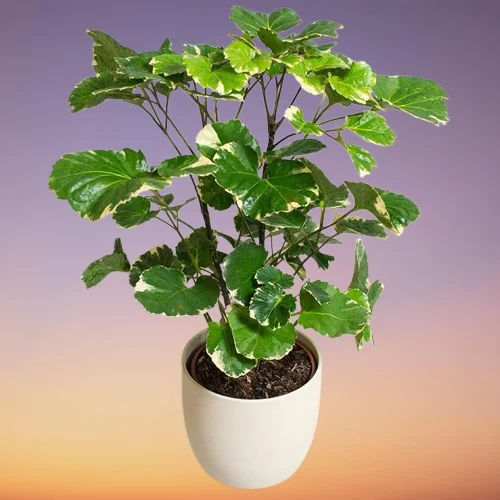
Botanical name: Polyscias balfouriana
Common names: Aralia balfouriana, Dinnerplate Aralia, Balfour Aralia
Origin: New Guinea to Queensland, Australia
Height: 8 ft
Aralia balfouriana is a large, tree-like plant which bears an abundance of attractive dark-green leaves and is perfect for a living room.
The charming Dinnerplate Aralia and its relatives Polyscias scutellaria (Shield Aralia) and Polyscias fruticosa (Ming Aralia) are spectacular plants for the large spaces to create a bold statement.
Polyscias balfouriana thrives in bright light away from direct sunlight, warm and humid conditions and moderately moist, fertile, well-drained soils coupled with monthly feeding during the growing season.
Read more on how to grow and care for Aralia balfouriana
11. Spineless Yucca

Botanical name: Yucca gigantea
Common names: Spineless Yucca, Soft-tip Yucca, Blue-stem Yucca, Giant Yucca, Yucca Cane, Itabo
Origin: Mexico and Central America
Height: 8-10 ft
Spineless Yucca an elegant False Palm for a living room with a woody trunk and a crown of long, leathery, strap-like, spineless leaves and white bell-shaped flowers on mature plants.
The Giant Yucca can grow in a variety of soils and is drought-tolerant. The major drawback for this plant is that it is highly susceptible to root-rot if grown in soggy soil.
Yucca gigantea requires very bright light, average warmth and humidity and moderately moist, well-drained, fertile soil coupled with monthly feeding during the growing season.
Learn more on how to grow and care for Spineless Yucca
12. Sicklethorn Fern

Botanical name: Asparagus falcatus
Common name: Sicklethorn Asparagus, Sicklethorn Fern, Large Forest Asparagus, Sickle-leaved Asparagus
Origin: South Africa, Mozambique
Height: 8 ft
Sicklethorn Fern also called Sicklethorn Asparagus, Large Forest Asparagus or Sickle-leaved Asparagus is a large, thorny, climbing plant which bears sickle-shaped 'leaves' and the stems are distinctly prickly hence the common name, 'Sicklethorn Fern'.
Sicklethorn Asparagus and its cousins Smilax Asparagus Fern (Asparagus asparagoides), Foxtail Fern (Asparagus densiflorus 'Meyeri'), Emerald Fern (Asparagus densiflorus 'Sprengeri') and Asparagus Fern (Asparagus plumosus) are easy-care plants which easily adapt to wide variations in light, heat and watering frequency.
Asparagus falcatus grows best in medium to bright indirect light, average warmth of 15-280C, moderate humidity of 50-55% and moderately moist, rich, well-drained, all purpose soils coupled with weekly feeding during the growing period.
Learn more on how to grow and care for Sicklethorn Fern (Asparagus falcatus)
13. Bamboo Palm

Botanical name: Chamaedorea erumpens
Common name: Bamboo Palm
Origin: Central and Northeastern Mexico
Height: 6-10 ft
Bamboo Palm is a spectacula, low light palm which is highly adaptable to a wide range of growing conditions and grows with a minimal outward spread making ideal for a compact space.
The magnificent Bamboo Palm is also a good indoor air cleaner which gets rid of xylene, toulene, benzene, formaldehyde and trichloethylene from indoor air.
Chamaedorea erumpens prefers bright, indirect light away from direct sunlight, average warmth and moderately moist, rich, well-drained soil coupled with regular feeding.
Read more on how to grow and care for Bamboo Palm
14. Corn Palm
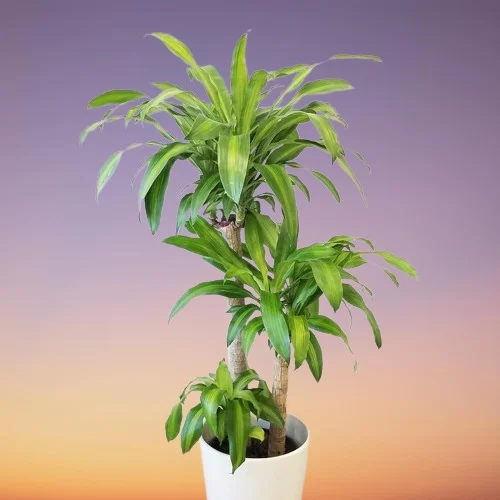
Botanical name: Dracaena fragrans
Common names: Corn Palm, Corn Plant, Striped Dracaena, Compact Dracaena
Origin: Sudan south, Mozambique, C么te d'Ivoire, Angola
Height: 6 ft
Corn Plant is low maintenace plant whose glossy, large, yellow-striped leaves will brighten up any space making it perfect for the living room.
The elegant Striped Dracaena is also a good indoor air cleaner and removes common VOCs like xylene, toulene, benzene, formaldehyde and trichloethylene from indoor air.
Dracaena fragrans thrives in bright, indirect light away from direct sunlight, average warmth and consistently moist, rich, well-drained soil coupled with monthly feeding.
Learn more on how to grow and care for Corn Palm
15. Alocasia 'Regal Shield'
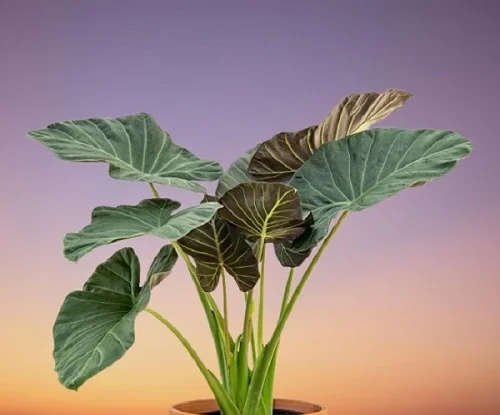
Botanical name: Alocasia odora X Alocasia reginula
Common names: Alocasia 'Regal Shield', Regal Shield Elephant Ear, Regal Shield Alocasia
Origin: Africa
Height: 5 ft
Alocasia 'Regal Shield' is one of the fast-growing plants which bears large, heart-shaped dark-green to almost black leaves with light-green venation on light-green stems.
Regal Shield Elephant Ear like Alocasia micholitziana (Green Velvet Alocasia) and Alocasia longiloba will make a bold statement in a living room on account of their size and spectacular foliage.
Regal Shield Alocasia grows best in bright indirect light away from direct sunlight, average warmth of 15-270C, humidity of 60-70% and moderately moist, fertile, well-drained, aroids potting soils coupled with monthly feeding during the growing season.
Read more on how to grow and care for Alocasia 'Regal Shield'
16. Ponytail Palm
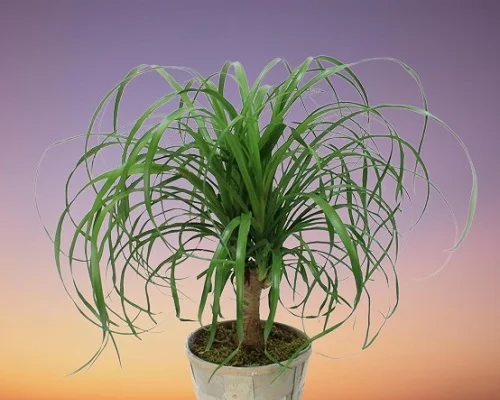
Botanical name: Beaucarnea recurvata
Common names: Ponytail Palm, Elephant Foot
Origin: Tamaulipas, Veracruz and San Luis Potosi in eastern Mexico
Height: 6 ft
Ponytail Palm is an easy care plant that does not require a lot of attention which makes it ideal for a beginner or the forgetful plant parent.
The elegant Ponytail Palm is a hardy plant with a swollen bulb which stores water, therefore, occasional dryness at the roots will do no harm to it.
Beaucarnea recurvata prefers bright light with some direct sunlight, average warmth and moderately moist, rich, well-drained soil coupled with monthly feeding during the growing season.
Learn more on how to grow and care for Ponytail Palm
17. Dracaena deremensis

Botanical name: Dracaena deremensis
Common name: Dracaena deremensis
Origin: Tropical Africa and Asia
Height: 4-6 ft
Dracaena deremensis is a slow-growing plant which bears dark-green foliage with one or more longitudinal stripes in a different color and comes in several varieties like Janet Craig, Warneckii, Lemon Suprise, Janet Craig Compacta among others.
Dracaena deremensis can reach a height of 4 feet or more when mature and the leaves are about 1.5 feet long. It is considered as one of the best large-leafed plants that make a bold statement in any space.
Dracaena deremensis flourish in bright indirect light (filtered light), average warmth of 18-270C, moderate humidity of 50-55% and consistently moist, rich, well-drained, all purpose soil coupled with monthly feeding in the growing season.
Read more on how to grow and care for Dracaena deremensis
18. Dumb Cane
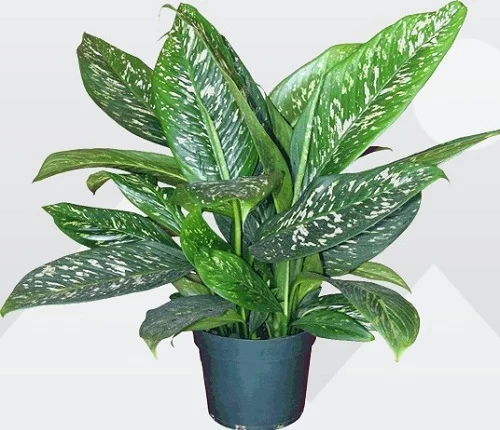
Botanical name: Dieffenbachia
Common name: Dumb Cane
Origin: Mexico, West Indies
Height: 5 ft
Dumb Canes are popular living room plants with large and highly decorative leaves, easy to grow and a good air cleaner. The leaves are simple and alternate containing white spots and flecks.
The common name, "Dumb Cane", is derived from the unpleasant effect of its poisonous sap on the mouth and throat. Dieffenbachia is poisonous to both humans and pets if ingested. Always wash hands thoroughly after handling.
Dieffenbachia thrives in bright indirect light away from direct sunshine, warm and humid conditions and moderately moist, fertile, well-drained soils coupled with fortnightly feeding during the growing season.
Learn more on how to grow and care for Dumb Cane
19. Lady Palm
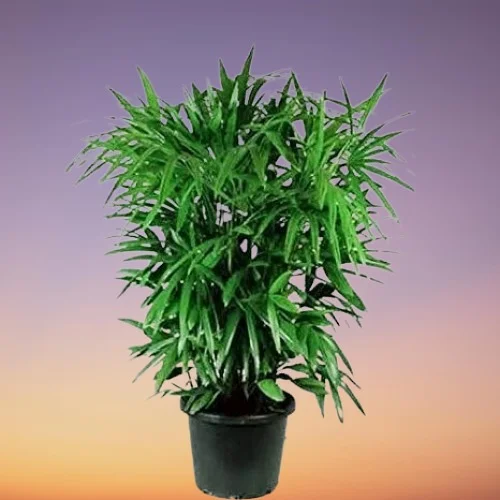
Botanical name: Rhapis excelsa
Common name: Lady Palm
Origin: India and Asia
Height: 6 ft
Lady palm is a small palm which grows in multi-stemmed clumps with glossy, evergreen leaves divided into broad, ribbed segments perfect for a living room.
The amazing Lady Palm produce fronds which are split into numerous segments radiating from a point at the base (fan-like segments like ladies fan), the segments may be entirely or only partly divided.
Rhapis excelsa grows best in bright to medium light, warm and moderately humid conditions and moderately moist, well-drained soil that is rich in organic matter coupled with monthly feeding during the growing season.
Read more on how to grow and care for Lady Palm
20. Japanese Aralia

Botanical name: Fatsia japonica
Common names: Japanese Aralia, Paperplant, Glossy-leaf Paper Plant
Origin: southern Japan, southern Korea and Taiwan
Height: 4-6 ft
Japanese Aralia is large, low-light, low-maintenance, hardy plant with air-cleaning properties which bears large, deeply lobed and leathery textured leaves perfect for a living room.
One of the striking Paperplant common varieties is Spider's Web or Spider White which bears variegated leaves.
Fatsia japonica grows best in medium to bright light, average warmth and moderately moist, rich, well-drained soil coupled with monthly feeding during the growing season.
Learn more on how to grow and care for Japanese Aralia
21. Weeping Fig
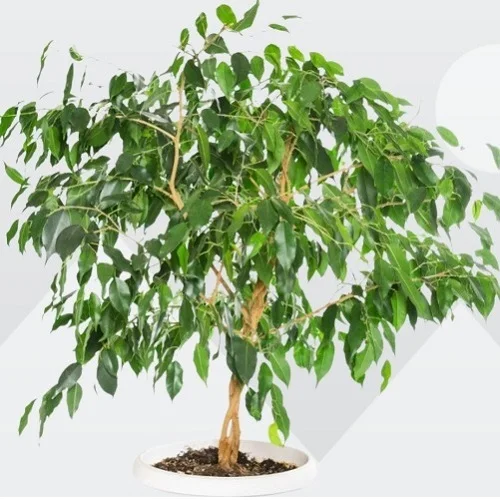
Botanical name: Ficus benjamina
Common names: Weeping Fig, Benjamin Fig, Ficus Tree
Origin: Asia and Australia
Height: 6-8 ft
Weeping Fig is a popular low light indoor plant due to its elegant growth and tolerance to poor growing conditions but it does not like sudden changes in light conditions.
The picturesque Benjamin Fig bears gracefully drooping branch-lets and glossy leaves, oval with an acuminate tip. The young foliage is light green and slightly wavy, the older leaves are green and smooth.
Ficus benjamina thrives in bright light with some direct sunlight, warm and humid conditions and moderately moist, fertile, well-drained soil coupled with monthly feeding during the growing season.
Read more on how to grow and care for Weeping Fig
22. Bird of Paradise Plant
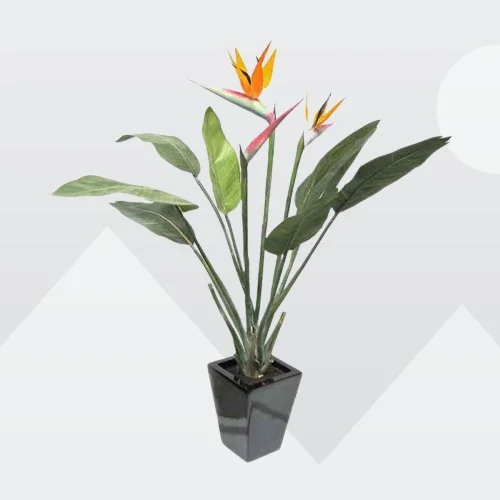
Botanical name: Strelitzia reginae
Common names: Bird of Paradise Plant, Crane Flower
Origin: South Africa
Height: 5-7 ft
Bird of Paradise Plant is one of the most spectacular flowering plants with vivid bright orange and blue flowers borne on top of tall stalks and surrounded by large leaves making it amazing for the living room.
The Crane Flower was described by Joseph Banks in 1788. The species name, 'reginae', means 'of the queen', in commemoration of the British queen Charlotte of Mecklenburg-Strelitz, wife of George III.
Strelitzia reginae requires bright light with some direct sunshine, cool to average warmth, humid conditions and consistently moist, fertile, well-drained soil coupled with monthly feeding during the growing season.
Learn more on how to grow and care for Bird of Paradise Plant
23. Rhaphidophora tetrasperma
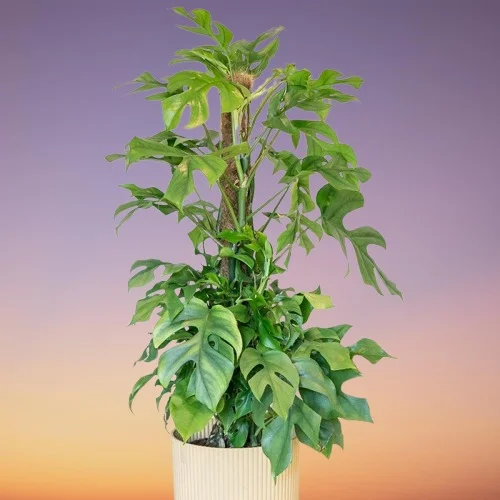
Botanical name: Rhaphidophora tetrasperma
Common name: Rhaphidophora tetrasperma
Origin: Southern Thailand and Malaysia
Height: 12 ft
Rhaphidophora tetrasperma, often incorrectly labelled as Mini Monstera, is one of the popular tropical foliage plants on account of it heart-shaped leaves with split lobes and trailing stems and is spectacular on a trellis or a moss pole.
You may find it mislabelled as a Monstera deliciosa or an Epipremnum pinnatum. However, Rhaphidophora tetrasperma belongs to the genus Rhaphidophora which comprises of about 100 species.
Rhaphidophora tetrasperma blossoms in bright indirect light, average warmth of 16-270C, humidity of 50-60% and moderately moist, fertile, well drained, aroids potting soil coupled with monthly feeding during the growing season.
Read more on how to grow and care for Rhaphidophora tetrasperma
24. Philodendron sagittifolium
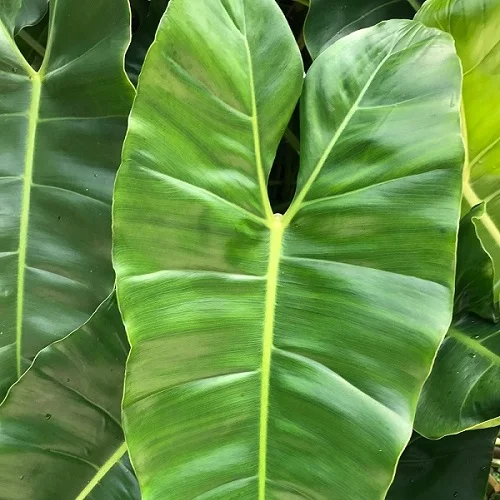
Botanical name: Philodendron sagittifolium
Common name: Philodendron sagittifolium
Origin: Brazil, Mexico, Peru
Height: 10 ft
Philodendron sagittifolium is one of the popular, vigorously-growing, climbing Philodendron varieties whose large, arrow-shaped leaves are pale green on top and the undersides are dark-green with light green spots ideal for a living room.
On account of its size and spectacular foliage, Philodendron sagittifolium like Philodendron hastatum (Silver Sword Philodendron), Philodendron domesticum (Spadeleaf Philodendron) and Philodendron selloum 'Sun Red' is one of the best large, low-light plants for the living room.
Philodendron sagittifolium flourishes in bright indirect light away from direct sunlight, average warmth of 18-250C, above average humidity of 60-70% and moderately moist, rich, well-drained, all purpose potting soils coupled with monthly feeding during the growing season.
Learn more on how to grow and care for Philodendron sagittifolium
25. Umbrella Tree
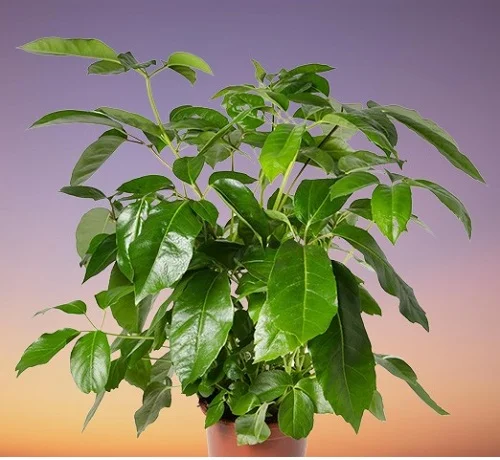
Botanical name: Schefflera actinophylla
Common names: Umbrella Tree, Octopus Tree, Australia Umbrella Tree, Queensland Umbrella, Amate
Origin: Queensland, Northern Australia, New Guinea and Java
Height: 6-8 ft
Umbrella Tree is one of the popular, easy to grow and propagate tree-like indoor plants and is ideal for the large spaces in a living room.
The eye-catching Australia Umbrella Tree gets its common name, 'umbrella Tree', from its large finger-like glossy leaflets radiating like umbrella spokes. The common name, 'Octopus Tree', is because of its spectacular, red-colored, tentacle-like flowers.
Schefflera actinophylla thrives in bright light away from direct sunshine, moderate warmth and moderately moist, rich, well-drained soil coupled with monthly feeding during the growing season.
Read more on how to grow and care for Umbrella Tree

